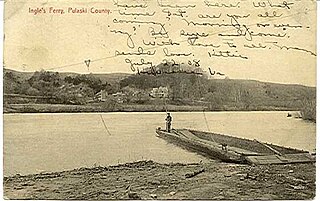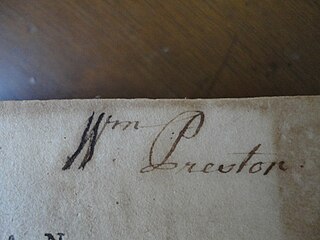
Lord Dunmore's War, also known as Dunmore's War, was a brief conflict in fall 1774 between the British Colony of Virginia and the Shawnee and Mingo in the trans-Appalachian region of the colony south of the Ohio River. Broadly, the war included events between May and October 1774. The governor of Virginia during the conflict was John Murray, 4th Earl of Dunmore, who in May 1774, asked the House of Burgesses to declare a state of war with the Indians and call out the Virginia militia.

Cornstalk was a Shawnee leader in the Ohio Country in the 1760s and 1770s. His name in the Shawnee language was Hokoleskwa. Little is known about his early life. He may have been born in the Province of Pennsylvania. In 1763, he reportedly led a raid against British American colonists in Pontiac's War. He first appears in historical documents in 1764, when he was one of the hostages surrendered to the British as part of the peace negotiations ending Pontiac's War.
Pickaway Plains is a wide area of rolling hills beginning about 3 miles south of Circleville, Ohio, and extending several miles to the north and south. This geological area was formed by sand and gravel deposited by melting water from the last glacier to retreat from the region during the Ice Age. During the time of inhabitation by the Shawnee, the Pickaway Plains were covered by prairie vegetation, mainly grasses.
Stephen Trigg was an American pioneer and soldier from Virginia. He was killed ten months after the surrender of Cornwallis at Yorktown in one of the last battles of the American Revolution while leading the Lincoln County militia at the Battle of Blue Licks, Kentucky.

Mary Draper Ingles, also known in records as Mary Inglis or Mary English, was an American pioneer and early settler of western Virginia. In the summer of 1755, she and her two young sons were among several captives taken by Shawnee after the Draper's Meadow Massacre during the French and Indian War. They were taken to Lower Shawneetown at the Ohio and Scioto rivers. Ingles escaped with another woman after two and a half months and trekked 500 to 600 miles, crossing numerous rivers, creeks, and the Appalachian Mountains to return home.

Lower Shawneetown, also known as Shannoah or Sonnontio, was an 18th-century Shawnee village located within the Lower Shawneetown Archeological District, near South Portsmouth in Greenup County, Kentucky and Lewis County, Kentucky. The population eventually occupied areas on both sides of the Ohio River, and along both sides of the Scioto River in what is now Scioto County, Ohio. It was added to the National Register of Historic Places on 28 April 1983. It is near the Bentley site, a Madisonville Horizon settlement inhabited between 1400 CE and 1625 CE. Nearby, to the east, there are also four groups of Hopewell tradition mounds, built between 100 BCE and 500 CE, known as the Portsmouth Earthworks.
Abram Trigg was an American planter, lawyer and politician who represented Montgomery County, Virginia in the Virginia Ratifying Convention and U.S. House of Representatives (1797-1809) after fighting with the Virginia militia in the Revolutionary War.

The Draper's Meadow Massacre was an attack in July 1755, when the Draper's Meadow settlement in southwest Virginia, at the site of present-day Blacksburg, was raided by a group of Shawnee warriors, who killed at least four people including an infant, and captured five more. The Indians brought their hostages to Lower Shawneetown, a Shawnee village in Kentucky. One of the captives, Mary Draper Ingles, later escaped and returned home on foot through the wilderness. Although many of the circumstances of the massacre are uncertain, including the date of the attack, the event remains a dramatic story in the history of Virginia.
Col. Johannes "John" Bowman was an 18th-century American pioneer, colonial militia officer and sheriff, the first appointed in Lincoln County, Kentucky. In 1781 he also presided as a justice of the peace over the first county court held in Kentucky. The first county-lieutenant and military governor of Kentucky County during the American Revolutionary War, Col. Bowman also, served in the American Revolution, many times, second in command to General George Rogers Clark, during the Illinois Campaign, which, at the time, doubled the size of the United States.

Toliver Craig Sr. was an 18th-century American frontiersman and militia officer. An early settler and landowner near present-day Lexington, Kentucky, he was one of the defenders of the early fort of Bryan Station during the American Revolutionary War. It was attacked by the British and Shawnee on August 15, 1782.
The Captives is a 2004 American film starring Elliot Miller, produced and directed by Jude Miller for Jude True Blue Productions. It is based on the true story of Mary Draper Ingles and her struggles during the French-Indian War. The film tells the story of Mary Draper Ingles and others in her settlement being taken captive to the Ohio Country by Shawnee Indian Warriors, and her journey home as she escaped from the tribe.

Ingles Ferry is the site of a historic ferry crossing on the New River in western Virginia, near the city of Radford in Pulaski County, Virginia, United States. A tavern was opened there in 1772 and the ferry served soldiers and civilians until 1948. A bridge was built at the site in 1842 but was burned during the civil war. The tavern and replicas of the 18th-century home of the Ingles family can be seen nearby.

Colonel William Preston was an Irish-born American military officer, planter and politician. He played a crucial role in surveying and developing the Southern Colonies, exerted great influence in the colonial affairs of his time, owned numerous slaves on his plantation, and founded a dynasty whose progeny would supply leaders of the South for nearly a century. He served in the House of Burgesses and was a colonel in the Virginia militia during the American Revolutionary War. He was one of the fifteen signatories of the Fincastle Resolutions. Preston was also a founding trustee of Liberty Hall when it was transformed into a college in 1776.
Hugh McGary was an Irish-born American military officer and landowner who was the founder of McGary Station in present-day Oregon, Kentucky.

Fort Vause was built in 1753 in Montgomery County, Virginia, by Ephraim Vause. The historic site is near the town of Shawsville, Virginia. It was attacked by French troops and Native American warriors in 1756, and most of the inhabitants were killed or taken prisoner. The fort was rebuilt in 1757 but abandoned by 1759.
Samuel Stalnaker was an explorer, trapper, guide and one of the first settlers on the Virginia frontier. He established a trading post, hotel and tavern in 1752 near what is now Chilhowie, Virginia. He was held captive by Shawnee Indians at Lower Shawneetown in Kentucky for almost a year, before escaping and traveling over 460 miles to Williamsburg, Virginia, to report on French preparations to attack English settlements in Virginia and Pennsylvania. He later served as a guide under George Washington during the French and Indian War.
The Sandy Creek Expedition, also known as the Sandy Expedition or the Big Sandy Expedition, was a 1756 campaign by Virginia Regiment soldiers and Cherokee warriors into modern-day West Virginia against the Shawnee, who were raiding the British colony of Virginia's frontier. The campaign set out in mid-February, 1756, and was immediately slowed by harsh weather and inadequate provisions. With morale failing, the expedition was forced to turn back in mid-March without encountering the enemy.
William Ingles, also spelled Inglis, Ingliss, Engels, or English, was a colonist and soldier in colonial Virginia. He participated in the Sandy Creek Expedition and was a signatory of the Fincastle Resolutions. He was eventually promoted to colonel in the Virginia Regiment. His wife, Mary Draper Ingles, was captured by Shawnee warriors and held captive for months before escaping and walking several hundred miles to her settlement. William's sons, Thomas and George, were also held captive, although William was able to ransom his son Thomas in 1768. William Ingles established Ingles Ferry in southwestern Virginia.
James Lynn Patton, was a merchant, pioneer frontiersman, and soldier who settled parts of Virginia's Shenandoah Valley. Between his immigration to Virginia in 1740, and his death there in 1755, he was a prominent figure in the exploration, settlement, governance, and military leadership of the colony. Patton held such Augusta County offices as Justice of the Peace, Colonel of Militia and Chief Commander of the Augusta County Militia, County Lieutenant, President of the Augusta Court, commissioner of the Tinkling Spring congregation, county coroner, county escheator, collector of duties on furs and skins, and County Sheriff. He also was President of the Augusta Parish Vestry and a member of the Virginia House of Burgesses. He was present at three important treaty conferences with Iroquois and Cherokee leaders. Patton was killed by Shawnee warriors in July 1755.
John Buchanan was a colonial Virginia landowner, magistrate, colonel in the Virginia Militia, deputy surveyor under Thomas Lewis, and Sheriff of Augusta County, Virginia. As a surveyor, Buchanan was able to locate and purchase some of the most desirable plots of land in western Virginia and quickly became wealthy and politically influential. As magistrate, sheriff and a colonel the Augusta County Militia, he was already well-connected when his father-in-law Colonel James Patton was killed in 1755. Buchanan had replaced Patton in several key roles by the time of his own death in 1769.










